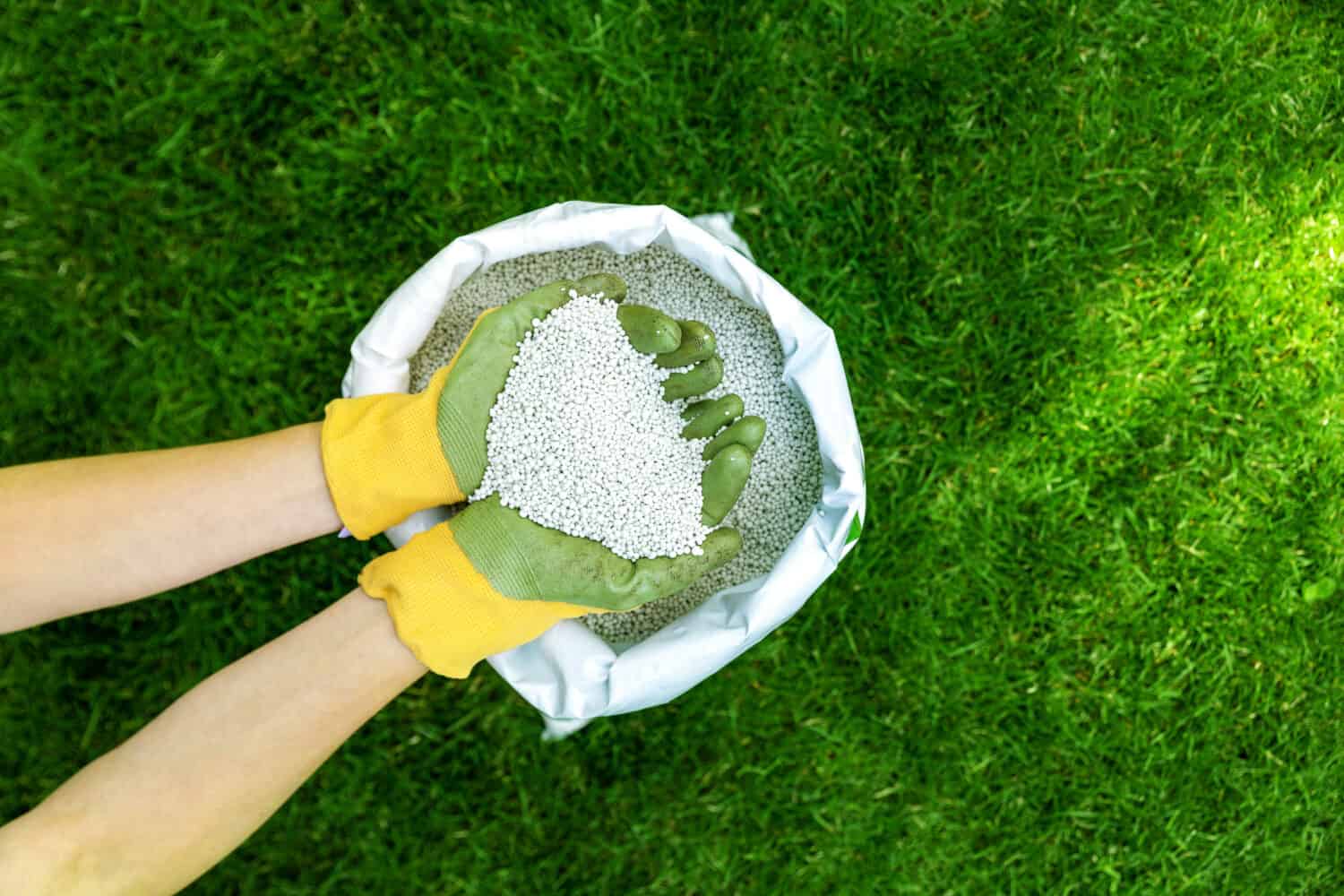If you want a healthy lawn, fertilizer is a crucial ingredient. Unfortunately, many people don’t fertilize their lawns because they don’t know which products to use or how to apply them. Furthermore, there is a specific way to apply fertilizer; if done incorrectly, it can do more harm than good. But when is the best time to fertilize your lawn? Continue reading to learn tips and tricks for a healthy, green lawn.
How Often To Fertilize a Lawn

When fertilizing a lawn, you must take the proper steps to achieve the desired result.
©ronstik/Shutterstock.com
As a rule, you should fertilize your grass at least once every six months to ensure it stays healthy and keeps its color. However, over-treating your grass or fertilizing it at the wrong time can cause weed growth or burn the lawn. Therefore, to avoid this situation, follow the rule of thumb, the best time to fertilize your lawn is while the grass is actively growing. Unfortunately, this time frame is not the same everywhere. It is determined by location and grass type. The two main types of grass in the USA is warm-season and cool-season grass. Furthermore, different types of transitional grasses grow well in areas where it’s too hot for cool-season grasses and too cold for warm-season grasses. So, once you learn what type of grass you have, you can find out when it is actively growing.
How to Fertilize a Lawn
When fertilizing a lawn, you must take the proper steps to achieve the desired result. Unfortunately, it’s not as simple as throwing it on your grass and hoping for the best. So, for a lush and healthy lawn, follow the steps below:
Prepare The Lawn
Fertilizer works best on a lawn that’s been prepped in advance. Therefore, mow the grass three to four days before spreading the fertilizer. Once you have mowed the lawn, remove any weeds because the last thing you want is for the weeds to soak up all the nutrients and spread. In addition, if necessary, dethatch the lawn. Furthermore, lightly water the lawn the night before applying fertilizer.
Choose the Right Day to Apply the Fertilizer
The best time to fertilize your grass is in the evening or when it’s overcast outside. Ideally, a spreader works best as it distributes the fertilizer evenly. However, you can also use your hands to scatter the fertilizer.
There are several types of spreaders that work for different scenarios. For example, a shoulder or hand-held spreader is best for a small or uneven lawn. But, if you have a large rectangular or square garden, the push-along spreaders are an excellent option.
Water After Fertilizing
Watering the lawn after fertilizing is essential as it gives the grass a chance to absorb the nutrients and stop the individual blades from getting burnt by the chemicals.
Inspect The Lawn After Fertilizing
A few weeks after you have fertilized the grass, inspect it for weeds. Remove any weeds you find, and fill the patches with fast-growing grass seeds.
Start the Fertilizing Process Again
How often you need to fertilize depends on the type of fertilizer you buy. For example, there are quick-release and slow-release fertilizers, and their effects vary. Quick-release fertilizers generally only last for a month, while slow-release fertilizers typically last for three to four months. Therefore, it’s always best to keep a diary to keep track of your fertilization process.
Which Are The Best Lawn Fertilizers To Use?
There are two forms of fertilizer, granule, and liquid. However, one is not necessarily better than the other due to the factors listed below:
Pick a Fertilizer According to the Season
There are fertilizers designed for different seasons. For example, one for spring and one for fall. But what’s the difference? Spring fertilizer has more nitrogen, which helps the grass rejuvenate and kick-start its growth. Furthermore, it prepares the lawn for oncoming warm weather. Summer fertilizer will help retain the healthy green color, avoid scorching, and nourish your grass. Autumn fertilizer must contain high amounts of potassium and phosphate to create healthy roots and get the lawn in good shape to survive winter. In addition, it will deter various pests that are damaging to your turf.
Avoid Cheap Fertilizers
Cheaper fertilizers generally contain high amounts of nitrogen, which may help short-term but is damaging after continual use. Therefore, you should always know your lawn’s needs. Fertilizers high in nitrogen encourage healthy coloration and growth. But, high amounts of phosphorus are good for growth.
When Is The Best Time To Fertilize A Lawn?
Once your grass is actively growing, the best time to fertilize it is on a cloudy day or in the evenings when the grass is damp and rain is on its way. Furthermore, the best months to fertilize your lawn are in March or April after most of the cold weather has passed. Then, again in July, to boost your lawn and help with the heat. Lastly, apply fertilizer in September or October to prepare your grass for the winter.
When is the Worst Time to Fertilize A Lawn?
The worst time to fertilize a lawn is when the ground is frozen or extremely dry. While it won’t harm the lawn, the grass’s roots won’t be able to absorb the fertilizer.
Are Lawn Fertilizers Safe To Use?
Most lawn fertilizers are safe to use but might harm pets that eat grass. Therefore, always check the packaging for contraindications. After fertilizing your lawn, keep your pets off the grass until it has a good post-feed soaking, which ensures the fertilizer moves off the grass into the soil below.
Are There Alternatives to Chemical Lawn Fertilizers?
Instead of using chemical lawn fertilizers, you can opt for an organic one. But you can make your own mulch if you want to be completely self-sustainable. Other alternatives include:
Bat Guano
You can buy bat guano at most garden centers that are either formulated with high nitrogen levels containing an NPK ratio of 10-3-1 or high phosphorous, with an NPK ratio of 3-10-1. Furthermore, when fertilizing with bat feces, mix five pounds per 100 square feet into the soil.
Fish Emulsions
While fish emulsions may have an unpleasant odor, it will fade after a few days. This fertilizer is made of partially decomposed and pulverized fish. In addition, it contains NPK ratios of 2-4-1. It is best to apply fish emulsion to your lawn in the late spring and thoroughly water the grass afterward.
Composted Manure
This is another fertilizer with a terrible odor, and its NPK ratio depends on the animal source. However, the rate is typically higher in fresh manures. Unfortunately, these cannot be applied to plant roots. Furthermore, application rates differ, so abide by the amounts listed in the instructions. For example, some manures need to be applied at a rate as low as 70 pounds per 1,000 square feet, while others need a rate as high as 500 pounds per 1,000 square feet.
Cottonseed Meal
This fertilizer is slightly acidic and generally contains an NPK of 7-3-2. It is filled with nutrients usually available to plants in warm soils. However, there is no risk of nitrogen burn, primarily associated with chemical fertilizers. As a result, cottonseed meal is perfect for acid-loving plants, and it needs to be combined with soil at a rate of 10 pounds per 100 square feet.
Alfalfa Pellets
These pellets generally contain an NPK ratio of 2-1-2. However, you need to be cautious when selecting Alfalfa pellets due to some brands containing weed seeds. The application requires mixing these pellets into the soil at a rate of two to five pounds per 100 square feet.
The photo featured at the top of this post is © SingjaiStocker/Shutterstock.com
Thank you for reading! Have some feedback for us? Contact the AZ Animals editorial team.







